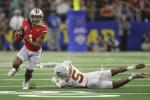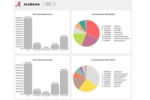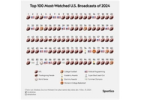College Sports is Breaking. Here’s How We Fix It.
College Sports is Breaking. Here’s How We Fix It.
We explain why college sports' cost crisis is only getting worse, and we propose a blueprint to restructure the system for the long-term
September 2025

Week One of college football delivered. We watched Arch Manning vs Ohio State, two other top-ten matchups, and a full Saturday of action.
As fans, we’re fired up about the college football season.
But as investors, we’re deeply concerned about the future of college sports.
At Will Ventures, we’ve closely tracked the shifting college sports landscape. Here’s an article we published one year ago, making an early case for private capital’s entrance into college sports.
Since that article, a lot has happened…
In May 2024, terms were reached for the House vs NCAA settlement. The plaintiffs agreed to the settlement for the immediate payday. They got $2.8B backpaid to former athletes, and a framework that lets schools share up to $20.5M of revenue annually with current and future athletes. Meanwhile, the NCAA and conferences took the deal to cap their downside. A final judgment could have forced not $2B, but up to $20B in backpay to former athletes. Simultaneously, the NCAA and conferences held out hope for Congress’ help. They hoped Congress would pass legislation protecting the House settlement’s framework and controlling revenue-sharing around $20.5M per school. (Otherwise, as we’ll explain, the framework has little chance of holding up in court and costs will push higher).
But Congressional action hasn’t come yet. House Republicans have pushed the SCORE Act. The bill would block student-athletes from being classified as employees, provide a federal antitrust exemption for the NCAA, and protect the $20.5M cap from future legal attack. In short, the bill would put the genie back in the bottle to protect the industry’s old ways of under-compensating athletes. The bill hasn’t reached the floor of the House yet. But even if it passes the House, the bill has little chance in the Senate, where 7 Democrats would need to cross the aisle.
The SCORE Act is likely the NCAA’s last hail mary, because focus will soon shift towards the mid-term elections and away from college sports. By the time focus shifts back to college sports in late 2026, the Democrats could control the House. It’s also worth noting in July, Trump signed his “Saving College Sports” executive order, which had few enforceable mechanisms. And more importantly, Trump getting involved probably made bipartisan cooperation even less likely. It’s clear the government isn’t coming to the rescue.
Now here’s the issue: In the absence of Congressional intervention, college sports is left with a massive cost problem.
The House settlement introduced a $20.5M revenue-sharing cap. But that cap isn’t collectively bargained – and therefore isn’t binding. So top athletic departments are using booster collectives to blow past the $20.5M cap. This season, Ohio State football will reportedly pay its players $35M, and Texas football might be spending up to $40M.
Athlete compensation is putting serious financial pressure on the system. As a result, fewer schools are able to truly compete in football and basketball – and more schools are slashing budgets for all other sports/
With everything that’s happened in the last year, one thing is increasingly clear to us: The current trajectory of college sports is unsustainable.
In part one of this essay, we’ll dive into why the college sports landscape is breaking post-House settlement. In part two, we’ll lay out a path forward for saving college sports.
Part 1: Why the college sports landscape is breaking
From a revenue standpoint, college sports is a massive business. D1 athletic programs drove $17.5B in revenues in 2022, thanks to major media and sponsorship deals. But from a cost standpoint, college sports never had to deal with its largest line item: player salaries. Whereas the NFL and NBA both share ~50% of revenue with players, universities historically got away for free. Since NCAA vs Alston in 2021, that’s changed. Costs are now ballooning, and there’s no system to control them.
Let’s break down this cost problem piece by piece.
First, revenue-sharing – starting at $20.5M per school and growing 4% annually – is about to put serious strain on schools. College sports might be a huge business. But most athletic departments are unprofitable or break-even. That’s because three sports make money and 30+ varsity sports lose money.
Take the University of Alabama. In 2023-24 Alabama drove $234M in revenue. About 70% of that came from football and basketball, which both turned a profit. But Alabama supports 27 varsity sports. So the athletic department ran a $30M deficit. An additional $20.5M from revenue-sharing is a big bump to that deficit.

On top of revenue-sharing, booster collective payments aren’t stopping. Before NIL, donors padded athletic departments’ bottom lines by paying for new facilities, scholarships, coaching endowments, and season ticket packages. But now, donors have to put that money towards recruiting a competitive roster. Fielding an SEC football team costs roughly $20M - $30M, and a men’s basketball team is another $5M - $8M. Few donor bases have unlimited funds (donor fatigue has become a buzzword). So as donors spend more on rosters, they’ll spend less on everything else – and that’ll further hit schools financially.
But that’s all just today’s problem. The cost problem is very likely to get worse. Further litigation is likely to push the costs of maintaining an athletic program even higher.
First, schools could soon get stuck paying all student-athletes a minimum wage. That’s the subject of the pending Johnson vs NCAA case. The plaintiffs are arguing that student-athletes fit the definition of an employee from the Fair Labor Standards Act. It’s hard to argue against it. Student-athletes have to show up on time for practices and games, follow schedules set by supervisors (coaches), and perform duties that generate revenue. If Johnson wins, then schools will have to pay minimum wages, payroll taxes, workers’ comp, and overtime for all its athletes. The average D1 school has ~500 athletes, so that could be upwards of $10M per school.
Second, we’re bound to see legal battles about whether the $20.5M cap is legal. Already, multiple groups have appealed the House settlement arguing the cap is wage-fixing. That’s a strong antitrust case: The settlement put an artificial cap on how much schools can spend, preventing athletes from earning their true market rate. Compensation caps are only lawful in the US when they’re negotiated through collective bargaining (i.e. how the NFL & NFLPA negotiated a salary cap) or granted via a federal antitrust exemption (which isn’t coming anytime soon). So if the cap’s thrown out, schools will end up sharing well north of $20.5M with athletes.
Third, we’ll likely see litigation around the regulation of booster collective payments. The House settlement established NIL Go, a clearinghouse to review all NIL transactions above $600. Its goal is to confirm payments are tied to “real value exchange” – and not straight pay-for-play. But the system is flawed from the start. It’s impossible to fairly evaluate every NIL deal of 190K D1 athletes. It should also be indefensible in court. Telling an athlete how much they can charge for an appearance is like telling any American how much they can charge for selling their house. Already athletes are complaining that they’re waiting weeks for deals to be approved and losing out on opportunities. If the guardrails on collective payments get shot down, collectives will effectively be another uncapped pool of player payments.
As a thought exercise, consider salaries in the NFL, where player salaries aren’t capped. The highest-paid coach Andy Reid makes $20M/year, and the highest-paid QB Dak Prescott makes $60M/year. That’s because a QB is more valuable than a coach, and market forces drive salaries. But today in college football, the highest-paid coach Kirby Smart makes $13M/year, and the highest-paid QB Darian Mensah makes $4M/year. In a free market where player payments aren’t capped, a top QB’s salary alone could push into the tens of millions.
So to summarize the cost problem: schools could soon be on the hook for paying athletes 1) minimum wages and employee benefits, 2) an uncapped amount of revenue-sharing, and 3) an unlimited amount via collectives.
To make things even worse, schools lack any major revenue levers to make up for these costs. The largest revenue lever, media rights, is unavailable – because all the Power conference, CFP and March Madness TV deals are locked up through 2030-35. Schools have solutions on the margins, like optimizing ticket sales, signing new sponsors, or (our favorite) re-releasing the NCAA Football video game. Some schools have also launched creative, new revenue streams with their collectives; for example check out Fanstake. But schools ultimately don’t have a real path to cover ballooning costs in the near term.
So how does the college sports landscape break? With the current trajectory, here’s what we believe will happen.
Schools will spend as much as possible to compete in the two revenue sports: football and basketball. SEC and Big-10 schools will dominate. ACC and Big-12 schools will struggle to keep up. Mid-majors will become much less competitive. And every school will angle themselves for the next wave of conference realignment and media rights paydays. Every school wants to avoid the fate of Oregon State and Washington State, who got stranded in the Pac-12.
Meanwhile, schools looking to compete in football and basketball will trim budgets (or outright cut) all other sports. As examples, Washington State consolidated its track and field program, and University of Louisiana Monroe slashed women’s tennis – both citing the House settlement.
We’re heading for a future where far fewer schools can compete in football and basketball, and far fewer schools can support dozens of sports programs.
Part 2: Here’s how we fix things
How do we save college sports as we know it? We believe two things are key to the solution: 1) external capital, and 2) collective bargaining.
ADs, coaches and other powerbrokers rejected both things at the start of the NIL era. But post-House settlement, these stakeholders are feeling the budget squeeze we laid out above. Increasingly, industry insiders view collective bargaining as the only way to get us off the litigation hamster wheel that college sports has been on for a decade now. And they view external capital as the only way to get college sports out of its current rut. Collective bargaining and external capital are also intertwined because investors would want to model out long-term costs and rules of the road via collective bargaining.
College sports is fortunate that it has many characteristics of a premium financial asset. College sports has cultural staying power; college football’s been the 2nd most-watched sport in the US since the 1980s. It has deep customer affinity; many alumni bases treat their fandom like religion. And it has large, diversified and recurring revenue streams; schools can monetize media rights, ticket sales, sponsorships, merchandise and more.

That’s why so many financial institutions have come around the table to propose different solutions. We’ve seen all of the above offered…
- Private credit: RedBird and Weatherford Capital co-launched Collegiate Athletic Solutions, discussing credit packages of $50M - $200M with individual schools.
- Private equity: CVC and the Big 12 discussed a $800M - $1B investment for a 15-20% equity stake.
- Restructuring: Smash Capital has done a roadshow for “Project Rudy,” a $9B capital infusion to restructure the entire FCS. College Sports Tomorrow is a consortium of pro team owners and sports executives that proposed a similar package.
The challenge with private capital at the school or conference level is that the cost problems we laid out above will continue to compound, and schools still don’t have major short-term revenue levers. It would also be a zero sum game for any one school or conference. If Ohio State or Texas raised capital, its Big 10 and SEC rivals would quickly follow suit. It’d simply accelerate the arms race for everyone without addressing the deeper structural problems.
That’s why we believe a restructuring of college sports is the only viable solution.
We believe the best option for everybody would look something like this:
- First, we reorganize the business of college sports. One entity representing the schools consolidates the rights to D1 college sports and serves as the financial and governance backbone of the system. This could be the NCAA, the CSC or even the CFP. This entity honors previous commercial agreements, but pools all media rights and other revenue streams under one roof. Media rights are the crux of all value creation, but it requires a centralized entity to optimize matchup quality and sell bundled rights. This could even be accomplished in the near-term by focusing only on postseason rights which are already aggregated (and not on conference rights which are locked up for now).
- Next, we establish collective bargaining. The entity representing the schools (mentioned above) negotiates with another entity that represents the athletes. These two entities negotiate a single master agreement covering core issues like player revenue-sharing, eligibility, transfers and benefits. They could adapt rules to the different realities of football, basketball and Olympic sports (think different pay scales, roster sizes, etc). The result would be cost certainty for schools, fairness and protection for athletes, and a system of rules that’s negotiated and enforceable long-term.
- Lastly, we bring in external capital and expertise. An outside investor injects capital into the entity representing the schools, in exchange for a minority equity stake. This multibillion-dollar investment is used to cover near-term financial obligations – including revenue-sharing, back-pay from the House settlement, and preservation of non-revenue sports. At the same time, the investor will offer operational support to optimize the next round of football and basketball media rights, and also build revenue streams for Olympic sports that have historically been neglected. Within a decade, schools will transition out of the current financial crisis and into a sustainable model where football and basketball thrive without hollowing out every other program. Note: A very specific investor profile would be required here. They’d need a massive balance sheet, an indefinite hold period, and interest in a premium asset.
We believe these three steps would establish a healthy college sports ecosystem.
Athletes would get a seat at the table and a voice in the future of college sports. They’d also get compensated for performing on a field or court, where billions of dollars in entertainment value is being produced.
Universities and conferences would get financial stability, an end to the litigation hamster wheel, and (finally) the ability to pick their heads up to start thinking about revenue growth and the next wave of media rights renewals.
And lastly, fans would get a competitive college football and basketball landscape – and 50+ varsity sports keeping their lights on.
Whether the powerbrokers of college sports are saying it publicly or not, they are increasingly discussing such possibilities. This future could be a lot sooner than the American public thinks.
We’re looking forward to seeing how the future of college sports plays out. And in the meantime, we’re excited for Week 2 of college football.